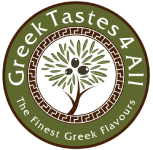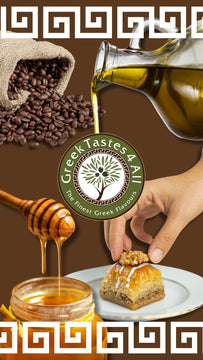Have Questions?Ask An Expert
Greek Mediterranean Risotto, Net 880g.
Trustify review stars will be displayed here!
-
Greek Mediterranean Risotto. Net weight 880g ( Pack of 4 boxes of 220g each ):
Risotto is a traditional Greek and Italian rice dish made from a Greek medium-grain white rice, traditional variety Carolina. The technique for making it is called the risotto method, which involves stirring small amounts of hot stock or broth into the rice a little at a time, allowing the liquid to be absorbed as you go. Risotto is special because the rice gives up some of its starch to make the dish so creamy. Adding butter and parmesan helps, but the stirring itself actually knocks some of that starch off the grains. Risotto is a Mediterranean rice dish cooked with broth until it reaches a creamy consistency. Risotto in Italy and Greece is normally the first course served before the main course.
How healthy is risotto? : Risotto is a great comfort-food dish, yet it also can be loaded with fat from the addition of butter and cheese. if you're feeding vegetarian friends, it can be the main course if you use vegetable broth rather than chicken broth. Rice is composed of carbs, with small amounts of protein and virtually no fat. Porcini mushrooms are a good source of B vitamins, protein, copper, potassium, zinc and selenium.
What sides to serve with risotto? : Sensitive aesthetes that they are, chefs often feel the need to gussy up or hide risotto. They scatter it with cosmetic toppings or secrete it away under a handsome wodge of protein (lamb loin, sea bass fillet, chicken breast), as if it can operate as a component part of a meal.
What meat goes well with risotto? : Greek traditional Mediterranean risotto on its own is a winner but adding succulent pork fillet (or tenderloin) cooked with garlic and fragrant rosemary just takes it up a notch. You could easily swap the pork out for beef fillet or chicken breasts if you were inclined.
Key Product Features:
i) Raw Ingredients, No Preservatives, Great Taste & High Nutritional Value.
ii) Basic to the Greek Mediterranean Diet, high in nutritional value with amazing taste. Suitable for vegetarians. Rice is composed of carbs, with small amounts of protein and virtually no fat.
iii) Risotto is a traditional Greek and Italian rice dish made from a Greek medium grain white rice, the traditional variety Carolina. The technique for making it is called the risotto method, which involves stirring small amounts of hot stock or broth into the rice a little at a time, allowing the liquid to be absorbed as you go.
Risotto is a great comfort-food dish, yet it also can be loaded with fat from the addition of butter and cheese. And if you're feeding vegetarian friends, it can be the main course if you use vegetable broth rather than chicken broth.Storage Instructions: Store in a clean, dry and cool place. In a pan over medium heat add olive oil & the rice Stir until the rice is lightly toasted for 2-3 minutes, then add 400ml of broth. Cook, stirring periodically to prevent the rice from sticking to the pan until the broth has been absorbed, about 3 minutes. Repeat with another 400ml broth until the liquid has been absorbed, 5 minutes more. Test the doneness of the rice. Remove the risotto pan from the heat and vigorously stir in the Parmesan cheese and butter. Season to taste.
-
Ingredients :
-
-
Greek Medium Grain White Rice Karolina Variety,
-
Sun-dried Tomatoes,
-
Onion,
-
Parsley / Basil / Chives (Dried) ,
-
Salt.
-
-
-
Cultivation under the Integrated Management Crop system ISO 22000:2005 and AGRO 2-1, AGRO 2-2 certified. Cultivation area: Serres, from rich plains of Macedonia in northern Greece.
-
Greek Mediterranean Risotto. Net weight 880g ( Pack of 4 boxes of 220g each ):
Risotto is a traditional Greek and Italian rice dish made from a Greek medium-grain white rice, traditional variety Carolina. The technique for making it is called the risotto method, which involves stirring small amounts of hot stock or broth into the rice a little at a time, allowing the liquid to be absorbed as you go. Risotto is special because the rice gives up some of its starch to make the dish so creamy. Adding butter and parmesan helps, but the stirring itself actually knocks some of that starch off the grains. Risotto is a Mediterranean rice dish cooked with broth until it reaches a creamy consistency. Risotto in Italy and Greece is normally the first course served before the main course.
How healthy is risotto? : Risotto is a great comfort-food dish, yet it also can be loaded with fat from the addition of butter and cheese. if you're feeding vegetarian friends, it can be the main course if you use vegetable broth rather than chicken broth. Rice is composed of carbs, with small amounts of protein and virtually no fat. Porcini mushrooms are a good source of B vitamins, protein, copper, potassium, zinc and selenium.
What sides to serve with risotto? : Sensitive aesthetes that they are, chefs often feel the need to gussy up or hide risotto. They scatter it with cosmetic toppings or secrete it away under a handsome wodge of protein (lamb loin, sea bass fillet, chicken breast), as if it can operate as a component part of a meal.
What meat goes well with risotto? : Greek traditional Mediterranean risotto on its own is a winner but adding succulent pork fillet (or tenderloin) cooked with garlic and fragrant rosemary just takes it up a notch. You could easily swap the pork out for beef fillet or chicken breasts if you were inclined.
Key Product Features:
i) Raw Ingredients, No Preservatives, Great Taste & High Nutritional Value.
ii) Basic to the Greek Mediterranean Diet, high in nutritional value with amazing taste. Suitable for vegetarians. Rice is composed of carbs, with small amounts of protein and virtually no fat.
iii) Risotto is a traditional Greek and Italian rice dish made from a Greek medium grain white rice, the traditional variety Carolina. The technique for making it is called the risotto method, which involves stirring small amounts of hot stock or broth into the rice a little at a time, allowing the liquid to be absorbed as you go.
Risotto is a great comfort-food dish, yet it also can be loaded with fat from the addition of butter and cheese. And if you're feeding vegetarian friends, it can be the main course if you use vegetable broth rather than chicken broth.Storage Instructions: Store in a clean, dry and cool place. In a pan over medium heat add olive oil & the rice Stir until the rice is lightly toasted for 2-3 minutes, then add 400ml of broth. Cook, stirring periodically to prevent the rice from sticking to the pan until the broth has been absorbed, about 3 minutes. Repeat with another 400ml broth until the liquid has been absorbed, 5 minutes more. Test the doneness of the rice. Remove the risotto pan from the heat and vigorously stir in the Parmesan cheese and butter. Season to taste.
-
Ingredients :
-
-
Greek Medium Grain White Rice Karolina Variety,
-
Sun-dried Tomatoes,
-
Onion,
-
Parsley / Basil / Chives (Dried) ,
-
Salt.
-
-
-
Cultivation under the Integrated Management Crop system ISO 22000:2005 and AGRO 2-1, AGRO 2-2 certified. Cultivation area: Serres, from rich plains of Macedonia in northern Greece.
RETURNS POLICY
Lorem ipsum dolor sit amet, consectetur adipiscing elit. Morbi ut blandit risus. Donec mollis nec tellus et rutrum. Orci varius natoque penatibus et magnis dis parturient montes, nascetur ridiculus mus. Ut consequat quam a purus faucibus scelerisque. Mauris ac dui ante. Pellentesque congue porttitor tempus. Donec sodales dapibus urna sed dictum. Duis congue posuere libero, a aliquam est porta quis.
Donec ullamcorper magna enim, vitae fermentum turpis elementum quis. Interdum et malesuada fames ac ante ipsum primis in faucibus.
Curabitur vel sem mi. Proin in lobortis ipsum. Aliquam rutrum tempor ex ac rutrum. Maecenas nunc nulla, placerat at eleifend in, viverra etos sem. Nam sagittis lacus metus, dignissim blandit magna euismod eget. Suspendisse a nisl lacus. Phasellus eget augue tincidunt, sollicitudin lectus sed, convallis desto. Pellentesque vitae dui lacinia, venenatis erat sit amet, fringilla felis. Nullam maximus nisi nec mi facilisis.
SHIPPING
Lorem ipsum dolor sit amet, consectetur adipiscing elit. Morbi ut blandit risus. Donec mollis nec tellus et rutrum. Orci varius natoque penatibus et magnis dis parturient montes, nascetur ridiculus mus. Ut consequat quam a purus faucibus scelerisque. Mauris ac dui ante. Pellentesque congue porttitor tempus. Donec sodales dapibus urna sed dictum. Duis congue posuere libero, a aliquam est porta quis.
Donec ullamcorper magna enim, vitae fermentum turpis elementum quis. Interdum et malesuada fames ac ante ipsum primis in faucibus.
Curabitur vel sem mi. Proin in lobortis ipsum. Aliquam rutrum tempor ex ac rutrum. Maecenas nunc nulla, placerat at eleifend in, viverra etos sem. Nam sagittis lacus metus, dignissim blandit magna euismod eget. Suspendisse a nisl lacus. Phasellus eget augue tincidunt, sollicitudin lectus sed, convallis desto. Pellentesque vitae dui lacinia, venenatis erat sit amet, fringilla felis. Nullam maximus nisi nec mi facilisis.

























